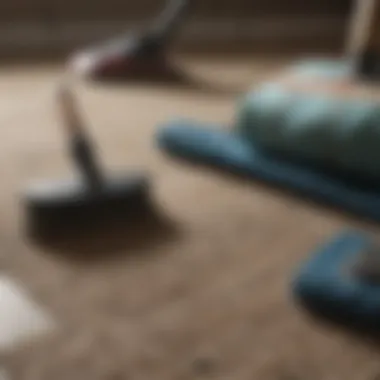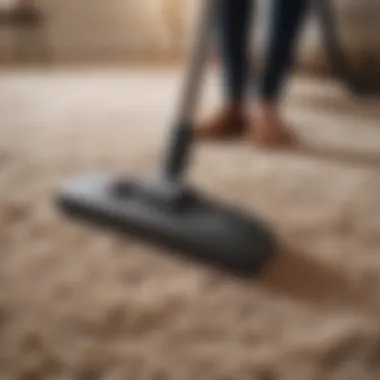Comprehensive Guide to Cleaning Area Rugs at Home


Intro
Cleaning area rugs at home involves various skills and knowledge. Each rug material has its own cleaning requirements. Recognizing these differences is crucial for effective maintenance. This guide aims to equip you with the necessary insights to keep your rugs looking their best.
The cleaning process begins with understanding the materials used in your rugs. Wool, silk, synthetic fibers each demands a tailored approach. Not knowing the right method can lead to damage. Not only do these materials affect how we clean, but they also influence the longevity and appearance of the rugs.
Regular care is also essential. By following a routine maintenance schedule, you can prolong the life of your area rugs. Vacuuming, spot cleaning, and professional cleanings are all part of this strategy.
In the following sections, we will explore cleaning techniques, identify types of materials, and share tips for maintaining the beauty of your rugs. Effective cleaning can enhance the aesthetic appeal of any space.
Why Cleaning Area Rugs Matters
Dirt and allergens can accumulate in area rugs over time. Proper cleaning can help reduce health risks. It also restores vibrancy and texture.
"Routine cleaning is essential to maintain a rug's value and appearance."
Moreover, an intricate or beautifully designed rug can serve as a focal point in a room. Ensuring it remains in good condition is imperative for interior design enthusiasts and homeowners alike.
By the end of this article, you will gain a comprehensive understanding of how to care for area rugs effectively. Let's now transition into the next section which will cover the varying materials used in rugs and their specific cleaning needs.
Preface to Area Rug Maintenance
Area rugs play significant roles in our homes. They are not just decorative items but serve practical purposes as well. An understanding of their maintenance is vital for prolonging their life and keeping them looking their best. Given their varied compositions and uses, different care methods apply based on the rug's material and the environment it resides in.
This section will delve into why maintaining your area rug is crucial. Regular maintenance prevents the buildup of dirt and allergens, ensures longevity, and maintains the visual appeal of the rug. Knowledge about proper cleaning techniques is necessary to avoid damaging these valuable assets.
A well-maintained rug can enhance the aesthetic of a room and provide comfort. Additionally, rugs can be investments, and proper care can help retain their value over time. Therefore, understanding the intricacies of rug care is key for home dwellers who appreciate their significance in interior design.
Understanding the Purpose and Importance of Area Rugs
Area rugs have multiple roles in a home. They act as foundational pieces, adding color and texture to spaces. Beyond aesthetics, they provide comfort underfoot and warmth during colder months. Rugs also absorb sound, creating a more serene atmosphere.
From a practical standpoint, area rugs protect the flooring beneath. They shield hardwood, laminate, or tile surfaces from scratches and wear. In high-traffic areas, they can prevent slips and falls, contributing to household safety.
Maintaining these rugs correctly does not only enhance their appearance but also upholds their functionalities. Regular cleaning helps in preserving these roles and ensures that the initial investment is not lost.
Challenges in Cleaning Area Rugs
Cleaning area rugs might seem straightforward, but various challenges can arise. One of the main issues is that rugs come in different materials, each requiring unique cleaning methods. For instance, what works for a wool rug could be catastrophic for a synthetic one.
Another significant challenge is the accumulation of dirt and allergens. Dust, hair, and spills can deeply penetrate rug fibers, making it difficult to achieve a thorough clean. Furthermore, stains can become permanent if not addressed swiftly and appropriately.
Inadequate cleaning products can also lead to damage, such as discoloration or weakening of fibers. It is critical to choose cleaning solutions tailored to the specific material of the rug.
Proper preparation and knowledge about cleaning techniques can mitigate these challenges. Investing time in learning about the distinctive needs of area rugs can save homeowners from costly mistakes in the long run.
Identifying Rug Materials
Identifying the materials of your area rug is vital for effective cleaning and maintenance. Each type of rug material has its own properties that influence how dirt, stains, and odors are dealt with. Understanding these characteristics ensures that you choose appropriate cleaning methods, which can greatly extend the life of your rug. Moreover, using the right technique based on the material can prevent damage that may arise from incompatible cleaning products or methods.
Natural Fiber Rugs
Natural fiber rugs, such as wool, cotton, and jute, offer unique attributes that require specific care. Wool rugs are known for their durability and softness, making them a common choice. However, they can be sensitive to water and can shrink or warp if not cleaned properly. Cotton rugs are easier to clean but may not withstand heavy traffic as well as wool. Jute and sisal rugs, while eco-friendly, can absorb stains and odors, necessitating a gentle cleaning approach.


To maintain natural fiber rugs:
- Regular Vacuuming: This prevents dirt buildup.
- Spot Cleaning: Spills should be attended to swiftly using a damp cloth.
- Professional Cleaning: Occasionally having them cleaned by specialists can help maintain their quality over time.
Synthetic Fiber Rugs
Synthetic fiber rugs, made from materials such as polyester or nylon, are often more stain-resistant and durable than their natural counterparts. These rugs are popular in homes with high foot traffic or children and pets due to their resilience. Most synthetic rugs can tolerate various cleaning methods, including machine washing, which simplifies maintenance. However, it is critical to check the manufacturer's recommendations to avoid any unexpected damage.
Key attributes of synthetic fiber rugs include:
- Versatility in Design: They come in a variety of patterns and colors.
- Stain Resistance: Many are treated to repel spills and stains.
- Easy Care: Usually can be cleaned with standard household cleaners without risk.
Specialty Rugs and Their Unique Care Needs
Specialty rugs, such as antique or heirloom pieces, demand a more individualized approach to cleaning. Their often delicate and unique fibers-such as silk or rare natural fibers-require specialized knowledge and products. Improper care can result in irreparable damage.
When caring for specialty rugs, consider:
- Gentle Cleaning Products: Using pH-balanced or specially formulated solutions is advisable.
- Consulting Experts: Seeking professional cleaning services familiar with specialty rugs can safeguard their integrity.
- Preventive Measures: Placing these rugs in low-traffic areas reduces wear and prolongs their aesthetic appeal.
Understanding the material of your area rug is crucial for its upkeep. This knowledge informs the best cleaning practices, ensuring your rugs retain their beauty and function.
Identifying the right rug materials is not just a preliminary step, but rather a foundational aspect of effective home care. By learning about each material's specific requirements, you can prolong the life of your area rugs, maintain their beauty, and save money in the long run.
Tools and Supplies for Rug Cleaning
Cleaning area rugs effectively is not just about the techniques; it is equally about having the right tools and supplies. Appropriate tools and products can enhance the cleaning process, making it easier and more efficient. Whether you are tackling a simple vacuuming job or performing a deep clean, understanding the tools at your disposal is paramount. Using the proper equipment will lead to a better cleaning outcome, extending the life and look of your rugs.
Essential Cleaning Tools
Investing in quality cleaning tools can make a significant difference. Here are some essential tools to have:
- Vacuum Cleaner: Opt for a vacuum cleaner designed specifically for rugs. These models typically work better on fibers and can remove dirt and debris without damaging the rug's surface.
- Soft-Bristled Brush: This tool is perfect for giving your rugs a gentle scrub without causing wear. It helps in loosening dirt that settles deep into fibers.
- Spray Bottles: Keep several spray bottles for diluted cleaning solutions. This allows for even application of your cleaning solutions.
- Microfiber Cloths: These cloths are essential for spot cleaning as they absorb liquid well and do not leave lint behind.
- Broom and Dustpan: For quick cleanups, a broom can be very helpful in gathering debris before vacuuming or deep cleaning your rug.
- Mop: For larger area rugs, a mop can be beneficial if you need to apply liquid cleaning solutions for a thorough clean.
Effective Cleaning Solutions
Choosing the right cleaning solutions is critical for maintaining the integrity of your area rugs. The wrong product can cause discoloration or even ruin delicate fibers. Consider the following options:
- Mild Detergents: A simple solution of water and mild dish soap often works well for most area rugs. Always test on a small, hidden area first to ensure it does not cause discoloration.
- Vinegar and Water Mixture: Vinegar is known for its deodorizing properties. Mix one cup of white vinegar with two cups of water for a natural cleaning solution. This is safe for most materials.
- Commercial Rug Cleaning Solutions: If searching for something specific, use a reputable product designed for your rug’s material. Make sure to follow the manufacturer’s instructions.
- Baking Soda: For odors and stains, sprinkling baking soda on the rug can absorb the smell. Vacuum it up after a few hours for a fresh feel.
In summary, having the right tools and solutions is foundational to a successful rug cleaning experience. Ensuring that you understand your requirements and the specific characteristics of your area rugs allows for an informed choice of products and equipment, ultimately leading to better care and maintenance.
Preparing to Clean Your Rug
Cleaning an area rug requires a careful approach. Before engaging in the act of cleaning, various factors need consideration. Preparation enhances the efficiency of the cleaning process and helps protect the integrity of the rug. The advantages of adequate preparation are numerous. It allows you to recognize existing damage, select appropriate methods, and minimize the risk of further wear and tear.
Assessing the Condition of Your Rug
Understanding the current state of your rug is essential before applying any cleaning techniques. Carefully examine for stains, wear, or areas needing special attention. Look for color fading, frayed edges, or any signs of moth damage. Identifying these issues early on can dictate your cleaning methods, ensuring they are appropriate for the material and condition of the rug.
Additionally, consider the environment in which the rug resides. If it is exposed to high foot traffic, the type of dirt and debris may differ from rugs in quiet settings.
Taking time to document the condition with photos may also be beneficial. This can serve as a reference point for future maintenance and help you track any changes over time.


Securing a Cleaning Space
A clean area to work on your rug is crucial during the cleaning process. Choose a location that allows for sufficient ventilation and is free from potential contaminants. Ideally, an open space will enable you to clean without cramping your movements.
Ensure the surface you are using is flat and stable to prevent any potential harm to the rug or yourself during cleaning. Using a tarpaulin or an old sheet can help protect the floor underneath. Having ample space allows for drying and other activities without exposing the rug to dust or debris during the cleaning process.
Creating a dedicated cleaning environment not only improves the process but also elevates the safety of your rug.
In summary, preparation is not just a step, but a necessity in cleaning area rugs effectively. By assessing the condition of the rug and securing an appropriate cleaning space, you set the stage for a thorough and considerate cleaning process.
Cleaning Techniques for Area Rugs
Cleaning techniques for area rugs are crucial in maintaining their beauty and extending their lifespan. Area rugs can accumulate dust, dirt, and stains over time, which can degrade their appearance and affect indoor air quality. Understanding the right methods to clean different types of rugs is essential. This not only preserves their aesthetic appeal but also ensures that they remain functional pieces of art in a home. By employing effective cleaning techniques, homeowners can avoid potential damage caused by incorrect methods and materials.
Vacuuming Your Rug
Regular vacuuming is one of the most significant things you can do to keep your area rug in good shape. It helps eliminate dirt and pet hair that can wear down the fibers over time. A good practice is to vacuum your rugs at least once a week.
When vacuuming, it's best to use a vacuum cleaner with a gentle setting. This prevents the vacuum from pulling on the fibers too hard, especially in rugs made from delicate materials. It is advisable to move the vacuum in different directions to raise dirt effectively from the base of the fibers.
Spot Cleaning Techniques
Accidents happen, and stains on rugs are inevitable. Spot cleaning is essential to address these issues promptly. When confronted with a spill, the first step is to blot the area with a clean, dry cloth to absorb excess liquid. Avoid rubbing, as this can spread the stain further into the fibers.
Use a mild detergent mixed with cool water to treat the stain. Apply the solution gently with a soft cloth, ensuring not to saturate the rug. Once the stain is lifted, blot the area with plain water to remove any remaining cleaning solution and then blot dry. Spot cleaning should be done as soon as possible for best results.
Deep Cleaning Methods for Different Materials
Deep cleaning follows the general maintenance of vacuuming and spot cleaning. Depending on the material of the rug, different methods can be employed to achieve a thorough clean.
Washing Natural Fiber Rugs
Washing natural fiber rugs is a delicate process. These rugs can be made from materials such as wool, cotton, or sisal. It is important to refer to care labels or consult with cleaning experts before proceeding.
Natural fibers can absorb water, making them susceptible to shrinkage or warping. It is common to use a gentle cleaning solution made for natural fibers. Care must be taken to rinse thoroughly to avoid residue, which may attract more dirt.
Cleaning Synthetic Rugs
Cleaning synthetic rugs is usually more straightforward. Materials like nylon or polyester are robust and resistant to stains. These rugs can often be machine washed, but you should always double-check the manufacturer's instructions. If machine washing is not advised, use a mixture of dish soap and warm water. Scrub gently with a brush and rinse thoroughly.
Synthetic rugs dry faster than natural fiber rugs, which makes them easier to clean regularly without significant worry about damage.
Special Instructions for Antique Rugs
Antique rugs require special care due to their age and the fragile nature of the fibers. Cleaning should be done infrequently and always by a professional, if possible.
You must avoid robust cleaning agents and high-pressure washing, as these can strip the rug of its natural dyes and ruin the fibers. Gently vacuuming and using a dry cleaning method with specialized products are often recommended. Antique rugs are valuable, and maintaining their condition is vital not just for appearance but also for preserving their investment value.
Drying and Post-Cleaning Care
The drying and post-cleaning care of area rugs is an often overlooked yet crucial part of the cleaning process. Proper drying techniques are essential not only to avoid damage to the rug’s fibers but also to prevent the onset of mold and mildew. After a thorough cleaning, moisture remaining in the rug can create an unhealthy environment that degrades the material and results in unpleasant odors. Therefore, knowing how to effectively dry and care for your rugs post-cleaning can significantly extend their lifespan and maintain their appearance.
Proper Drying Techniques


To effectively dry your area rug, consider these key techniques:
- Air Drying: The best drying method involves removing excess water and allowing the rug to air dry. Use a clean towel to blot and absorb moisture before laying the rug flat in a well-ventilated area.
- Elevated Position: If possible, hang the rug over a railing or a sturdy surface. This allows air to circulate around all sides, promoting even drying.
- Avoid Direct Sunlight: While sunlight can aid in the drying process, direct exposure may cause colors to fade. Choose a shaded area for the drying process.
- Use of Fans: Position fans around the rug to enhance air circulation. This can significantly reduce drying time, ensuring moisture evaporates quickly.
- Flip the Rug: If the rug is thick, it may be beneficial to flip it halfway through the drying process. This allows both sides of the rug to dry evenly.
- Check for Residual Moisture: Once the rug feels dry, check for any remaining dampness, especially in thick pile areas. The goal is to ensure the rug is completely dry to inhibit mold growth.
Effective drying is critical in rug maintenance. A well-dried rug will last longer and retain its richness.
Post-Cleaning Maintenance Tips
After cleaning and drying, maintaining the rug becomes the next priority. Here are some maintenance tips to keep your area rugs in excellent condition:
- Regular Vacuuming: Frequent vacuuming, ideally weekly, helps to prevent dirt and debris buildup. This helps maintain the rug’s cleanliness and vibrancy.
- Stain Protection: Consider applying a fabric protector, such as Scotchgard, to create a stain-resistant barrier against spills and dirt.
- Rotate the Rug: Rotating the rug every few months helps distribute wear evenly and prevents fading from sunlight exposure in specific areas.
- Schedule Professional Cleaning: Depending on the rug’s material and usage, consider professional cleaning every 2-3 years. This can remove deep-seated dirt and restore the rug’s appearance.
- Immediate Attention to Spills: Address any spills as soon as they occur, using the appropriate spot cleaning technique for your rug’s material.
By adhering to proper drying techniques and implementing consistent post-cleaning maintenance, area rugs can remain both functional and aesthetically pleasing for years to come.
Common Mistakes to Avoid
Cleaning area rugs can seem like a simple task, but several common missteps can undermine your efforts. Recognizing and avoiding these mistakes is crucial for maintaining the longevity and beauty of your rugs. The following sections will delve into specific errors to be mindful of, providing insights on how to prevent them.
Using Incorrect Products
One of the most significant missteps in rug care is the use of inappropriate cleaning products. Each type of fiber requires distinct cleaning solutions. For instance, using strong detergents on natural fiber rugs can lead to significant damage. These products may strip away essential oils, leading to a rough texture and faded colors. On the other hand, synthetic rugs are often more resilient, yet using overly harsh chemicals can still compromise their integrity over time.
To avoid this mistake, always read labels carefully and consult care instructions specific to your rug's material. Using a mild detergent or a specialized cleaner is usually the best course of action. Moreover, conducting a spot test on a small, inconspicuous area can help identify any adverse reactions before applying a product to the entire rug.
"Using the wrong cleaner can turn a simple cleaning operation into irreversible damage, impacting both the look and lifespan of your rug."
Rushing the Cleaning Process
Cleaning area rugs requires careful attention, and rushing through the process is another common mistake. Many homeowners think that a quick vacuuming session is sufficient, failing to realize that deeper cleaning is necessary for maintaining the rug's appearance and hygiene.
When you hurry, you might miss areas that require special attention or neglect effective techniques such as spot cleaning. Additionally, drying time becomes critical. A damp rug can lead to mold and odors, which further complicate cleaning efforts. It is essential to allocate adequate time for each step, including vacuuming, treating stains, washing (if applicable), and allowing for thorough drying.
Neglecting Regular Maintenance
Regular maintenance is vital for any area rug. Unfortunately, many individuals overlook this aspect until problems arise. Neglecting to perform routine upkeep can lead to a build-up of dirt, dust, and allergens, which not only affects the aesthetics but also poses health risks.
Establishing a regular cleaning schedule that includes weekly vacuuming and monthly deeper cleaning can preserve the rug's appearance and prolong its lifespan. Even rotating the rug periodically can help prevent uneven wear. Monitoring its condition regularly will allow you to address minor issues before they escalate.
By being aware of these common mistakes, you can make informed decisions that contribute to the longevity and beauty of your area rugs, ensuring they remain a treasured element of your home.
Ending and Best Practices
Cleaning area rugs is not a straightforward task. It requires diligence and a proper understanding of the materials at hand. This section highlights the importance of implementing the best practices discussed throughout the article. Following a structured approach not only preserves the aesthetic appeal of your rugs but also helps in extending their lifespan.
Utilizing the right cleaning methods reduces the risk of damage. Moreover, integrating a regular care routine ensures that your area rugs remain in top condition, free from dirt and allergens. Ultimately, the goal is to maintain their beauty while safeguarding the environment within your home.
"Regular maintenance is the key to a long-lasting and beautiful area rug."
Summary of Key Takeaways
- Regular cleaning is essential.
Aim to vacuum your rugs weekly or bi-weekly. This helps remove dirt and dust before it settles deeper into the fibers. - Understand your rug material.
Knowing whether your rug is made of natural fibers, synthetic materials, or something special dictates the cleaning method you should use. - Use appropriate cleaning solutions.
Avoid harsh chemicals that can strip colors or damage fibers. Opt for mild products or natural cleaning alternatives. - Tackle stains immediately.
The quicker you respond, the easier it will be to remove stains. - Incorporate a proper drying process.
Allow rugs to dry thoroughly to prevent mold and odor build-up.
Establishing a Regular Care Routine
To ensure sustainability in your area rug maintenance, establishing a regular care routine is vital. Consider the following tips:
- Set a Cleaning Schedule: Decide a frequency for major cleanings based on foot traffic and rug location.
- Rotate Your Rugs: Changing the positions of your rugs helps prevent uneven wear and fading.
- Inspect Periodically: Look for signs of damage or stains to address them promptly.
- Store Properly: If you need to store a rug, ensure it is clean and rolled instead of folded to avoid creases.
- Consult Professionals When Needed: For extensive cleaning or repairs, consider hiring professionals experienced in rug care to avoid home remedies that could cause damage.
By adopting these practices, you can ensure that your area rugs not only look good but also contribute positively to your home's atmosphere.







